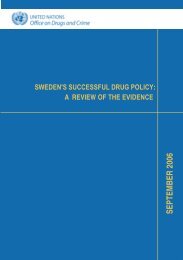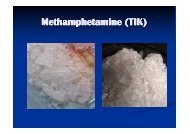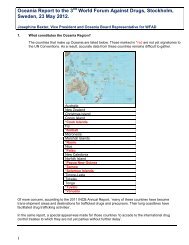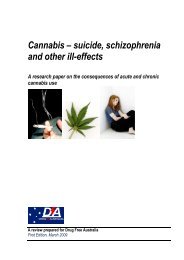International Research Compendium - Drug Free Australia
International Research Compendium - Drug Free Australia
International Research Compendium - Drug Free Australia
Create successful ePaper yourself
Turn your PDF publications into a flip-book with our unique Google optimized e-Paper software.
substance use or dependence will become dependent, and likewise some of those<br />
who become dependent will not carry that particular risk factor.<br />
These genetic contributions to vulnerability seem likely to be distributed over several<br />
distinct regions ( loci ) on the chromosomes. The chromosomes are made up of a<br />
distinct set of instructions, (or genes) that “code” for proteins.<br />
One overwhelming finding from genetic studies of psychoactive substances is that<br />
the heritability ( genetic contribution ) of dependence for one substance correlates<br />
highly with dependence for other substances. For example, recent studies of ethanol<br />
and tobacco use by humans suggest that common genes may influence the<br />
dependence on tobacco and ethanol.<br />
People who smoke are also at greater risk for severe alcohol dependence. This may<br />
occur by diminishing the effects of alcohol, because nicotine can increase the activity<br />
of the alcohol-metabolising enzyme CYP2E1. Alcohol dependence is associated with<br />
more serious nicotine withdrawal. Data from twin studies suggest that cigarette<br />
smoking may contribute to the development of tolerance to the effects of alcohol and<br />
a diminished sense of intoxication, suggesting that smoking induces increased<br />
alcohol metabolism.<br />
Twin studies that have been done in several countries over several decades show<br />
evidence that addiction has an inheritable component. Regardless of the foster<br />
parent family environment, adopted children developed alcohol abuse or abstinence<br />
patterns similar to their biologic parent’s use of alcohol. Statistics (USA ) show that if<br />
one biological parent were alcoholic, a male child was about 34% more likely to be an<br />
alcoholic than the male child of non-alcoholics. If both biological parents were<br />
alcoholic, the child was about 400% more likely to be alcoholic.<br />
There are 2 main types of genes that have been associated with drug dependence:<br />
those that are likely to be specific to the particular drug dependence and those that<br />
may play a common role in either all or a subset of dependencies.<br />
Genes related to smoking:<br />
There is some evidence that smoking behaviour is associated with at least 14<br />
different chromosomal locations. Studies suggest that the effect of any one gene on<br />
smoking behaviour is likely to be weak. The genes involved in nicotine metabolism<br />
may be important risk factors for smoking; for example, the metabolic enzyme<br />
CYP2A6 is responsible for about 90% of the metabolic inactivation of nicotine to<br />
cotinine.<br />
Candidate genes for alcohol dependence:<br />
Alcohol is metabolised to acetaldehyde, which in turn is metabolised to acetate<br />
before elimination from the body. The mitochondrial form of aldehyde dehydrogenase<br />
( ALDH2 ) is the enzyme primarily responsible for the metabolism of acetaldehyde to<br />
acetate. ALDH2 deficiency leads to an averse response to alcohol due to elevated<br />
levels of acetaldehyde, resulting in increased hangover symptoms, and the alcohol<br />
flushing response.<br />
Alcoholdehydrogenase ( ADH ) metabolises alcohol to acetaldehyde.<br />
The subtype ADH2*2 is lower in populations with alcohol dependence, indicating a<br />
protective effect.<br />
Cytochrome P-450 2E1 ( CYP2E1 ) is a hepatic enzyme that also metabolises<br />
ethanol to acetaldehyde. The levels of hepatic CYP2E1 activity in humans were<br />
found to vary by 15-fold. Nicotine increases hepatic CYP2E1 activity.<br />
Chronic ethanol consumption results in the induction of CYP2E1, which is believed to<br />
play an important role in the pathogenesis of alcohol-induced liver disease and is<br />
7






